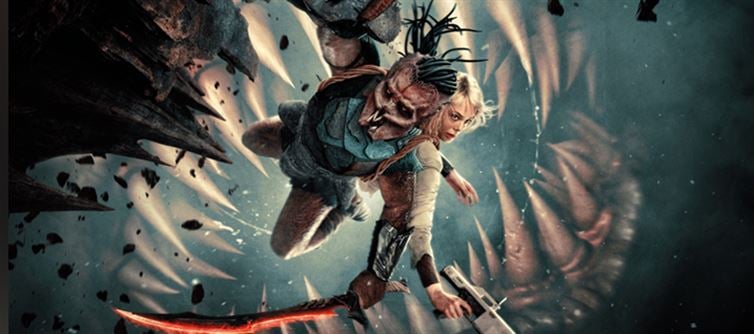
Story: The Hunt Reimagined
Predator: Badlands dares to tread where few franchise films dare — into emotional territory. Set against the backdrop of two dying worlds, the story follows Dek, a young, undersized Yautja (Predator) struggling to prove himself worthy of his clan. His rite of passage — to hunt and return with the head of a mighty prey — takes a brutal turn when his own father, the ruthless clan leader, orders his death for being “weak.”
Barely escaping execution, Dek sets course for Genna, a nightmarish death planet ruled by the colossal beast Kalisk. His journey intertwines with Thia (Elle Fanning), a half-destroyed Weyland-Yutani synthetic, who offers to guide him to Kalisk in exchange for help returning to her base. Together, they form an unlikely alliance — a runt Yautja and a broken machine — on a planet where everything wants them dead.
What unfolds is a surprisingly tender exploration of belonging, family, and the blurred lines between predator and prey. At its heart, Badlands is less about the hunt and more about what it means to have something worth fighting for.
Performances: Ferocity Meets Fragility
Dimitrius Schuster-Koloamatangi delivers a phenomenal breakout performance as Dek, embodying both the physical ferocity and emotional vulnerability of a character who barely speaks any english — yet communicates volumes through posture, gaze, and guttural alien speech. His performance, combined with next-level prosthetics and motion capture, gives the Yautja species its most layered depiction yet.
Elle Fanning is equally magnetic in dual roles as Thia and Tessa — two synthetic “sisters” whose contrasting programming explores the emotional ethics of artificial intelligence. As Thia, Fanning brings heartbreaking depth and dark humor to a role that could have easily been robotic. As Tessa, she channels icy malice with surgical precision, embodying corporate corruption with a smile.
Together, Dek and Thia’s chemistry becomes the film’s emotional engine. Their bond feels genuine and earned, transcending species, logic, and even machinery. Add in Bud, the weirdly adorable reptilian-ape creature who becomes their unlikely sidekick, and you get a found family dynamic that feels both strange and sincere — the kind of emotional layering the Predator franchise has never dared attempt before.
Technicalities: A Cinematic Huntmasterpiece
Visually, Predator: Badlands is pure spectacle. director Dan Trachtenberg, reuniting with cinematographer Jeff Cutter (Prey, 10 Cloverfield Lane), crafts a world dripping with primal chaos and vivid color. Every frame feels alive — dripping blood, alien dust, and the pulse of survival.
The action sequences are ferocious ballets of brutality, each more inventive than the last. From Dek’s desperate brawls against Genna’s monstrous fauna to the towering showdown with Kalisk, every set piece feels tactile and earned.
The VFX and practical effects are near-flawless. Studio Gillis outdoes itself with Dek’s creature suit — a masterpiece of design — while Wētā FX adds seamless enhancements without smothering the practical authenticity.
And then there’s the language — the film’s boldest artistic gamble. Linguist Britton Watkins developed a fully functional Yautja tongue, complete with syntax and phonetics. It’s a masterstroke that adds immersion, giving the Predator species true cultural texture for the first time in franchise history.
Analysis: Evolution Over Extinction
Where Badlands truly triumphs is in its refusal to play safe. It doesn’t rely on nostalgia or endless callbacks — it evolves the mythology. The film’s script by Brian Duffield (No One Will Save You) and Patrick Aison (Prey) layers the familiar Predator themes — survival, dominance, legacy — with philosophical introspection.
By placing a Yautja at the emotional center and pairing him with a half-human synthetic, the film challenges the audience to question the concept of monstrosity itself. Who is truly the predator — the hunter born to kill, or the machine programmed to feel nothing?
The inclusion of Weyland-Yutani may hint at an eventual Alien vs. Predator thread, but Trachtenberg wisely uses it for thematic depth rather than cheap franchise bait. He’s not smashing toys together; he’s sculpting new ones with purpose.
Critics who dismiss the film as “Disney-fied” miss the point entirely. Badlands isn’t softening Predator — it’s humanizing brutality without declawing it. It’s what The Last Jedi did for Star Wars — bold, divisive, but necessary.
What Works ✅
🔥 Dek and Thia’s emotional arc – the beating heart of the film.
🎥 Breathtaking cinematography and alien world-building.
💀 Inventive, visceral action sequences that outdo prior entries.
🎭 Elle Fanning’s dual performance – haunting, human, and chilling.
🧠 Cultural depth – a full Yautja language and lore expansion.
🧩 Smart, standalone storytelling that respects continuity without relying on it.
What Doesn’t ❌
⏳ Slight pacing drag in the second act’s quieter middle portion.
💬 Some fans may resist the emotional tone shift from traditional Predator ruthlessness.
👽 Minor underuse of the Kalisk, the titular beast, who feels more symbolic than central.
Bottom Line: The Predator Evolves — And So Should We
Dan Trachtenberg’s Predator: Badlands isn’t just another hunt — it’s a rebirth. Brutal yet soulful, violent yet tender, it proves that evolution, not repetition, is what keeps legends alive.
Whether you come for the blood, the spectacle, or the surprising heart, Badlands delivers on all fronts — reminding us that even monsters can have meaning.
Rating: ⭐ 4.5/5
India Herald Meter: 🩸 91% – Savage, Spectacular, and Surprisingly Sentimental




 click and follow Indiaherald WhatsApp channel
click and follow Indiaherald WhatsApp channel